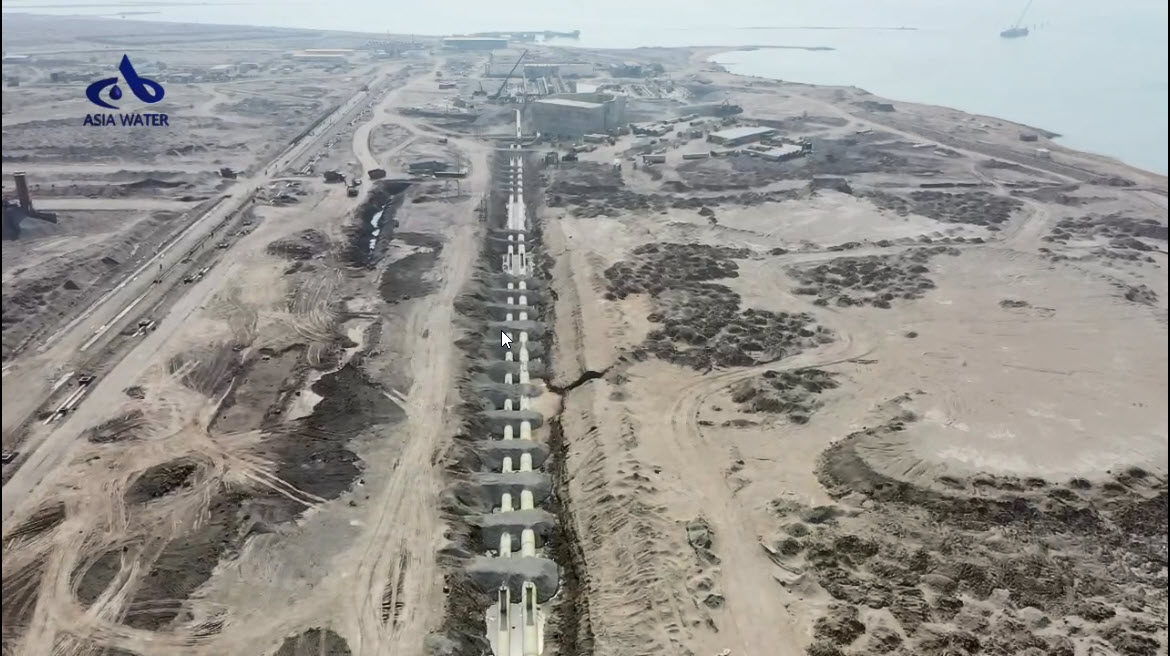Infrastructure Section

The implementation of the necessary infrastructure for desalinating seawater at a capacity of 1.4 million cubic meters per day includes:
Intake Structure
A concrete reservoir measuring 95 meters in length, with a variable width ranging from 48 to 91 meters and a depth of 12 meters, is designed to pump water at a capacity of 4,500,000 cubic meters per day and features 7 active inlets. At the beginning of the intake structure, a Bar Screen is installed to remove materials larger than 25 millimeters, followed by a Band Screen designed to eliminate particles larger than 3 millimeters. Additionally, 19 pumps, each with a capacity of 1,640 kW, are designated for transferring seawater from the intake to the desalination facilities.
Effluent Discharge Structure
The effluent discharge structure (Weir Box) has the capacity to discharge 3,200,000 cubic meters of water per day. This structure is semi-buried and uses three pipes with a diameter of 2.5 meters to transfer wastewater, in accordance with environmental standards, to a depth of 10 meters at a distance of 2,300 meters into the sea.

Marine Pipelines
Seawater intake occurs 1,200 meters from the intake structure and at a depth of 10 meters, utilizing suction chambers. These chambers prevent larger marine organisms from entering by acting as a primary filter through suction. There are seven suction chambers located on the seabed, from which water is transferred to the intake structure via seven gravity-fed polyethylene pipes, each with a diameter of 2.5 meters.

Onshore Water Transfer Lines
After the seawater intake and the removal of particles larger than 3 millimeters at the intake structure, the incoming water is transferred to the desalination units and pre-treatment section through GRP (Glass Reinforced Plastic) water transfer pipelines.

Desalinated Water Storage Tanks
The fresh water produced by the desalination units is transferred to nine storage tanks. To strengthen the foundation bed beneath each freshwater tank, approximately 440 piles, each measuring 30 to 40 meters in length, have been installed.

63/33 and 11 kV Substation
The electrical power required for the complex is provided through the construction of a dedicated 63/33 and 11 kV substation, and it is distributed to the consumption sites via the transmission and distribution network.

Intake Structure Substation
This substation is located within the intake structure area and is specifically responsible for supplying and distributing electricity to the intake facility.

Chlorination Building
This structure is also located within the intake area and is responsible for the three-point injection of chlorine during the intake process, prior to the water being transferred through the onshore pipelines.

Administrative Area
The administrative area includes office buildings, a clinic, a dining hall, a guesthouse, parking facilities, and a dedicated substation, covering a total area of 3,000 square meters.
Other Infrastructure Facilities
These include a reservoir and irrigation pumping system for green spaces, a weighbridge area, a pumping station for seawater intake, guardhouses, a workshop building, a storage facility, a bottled drinking water factory, a helicopter landing pad, and more.

